2 Understand What the Oracle Fusion Applications Environment Looks Like
It includes the following topics:
2.1 Introduction to What the Oracle Fusion Applications Environment Looks Like
Once fully installed, the Oracle Fusion Applications environment contains several Oracle as well as third party products which make up its technology stack. Oracle Fusion Applications is built on the Oracle Fusion Middleware stack and uses Oracle Database.
Understanding what the environment looks like after the installation process is complete helps to better understand the installation process, and plan for the installation so as to fit the desired environment configuration.
The Oracle Fusion Applications architecture is depicted in the following diagram.
Figure 2-1 Oracle Fusion Applications Architecture
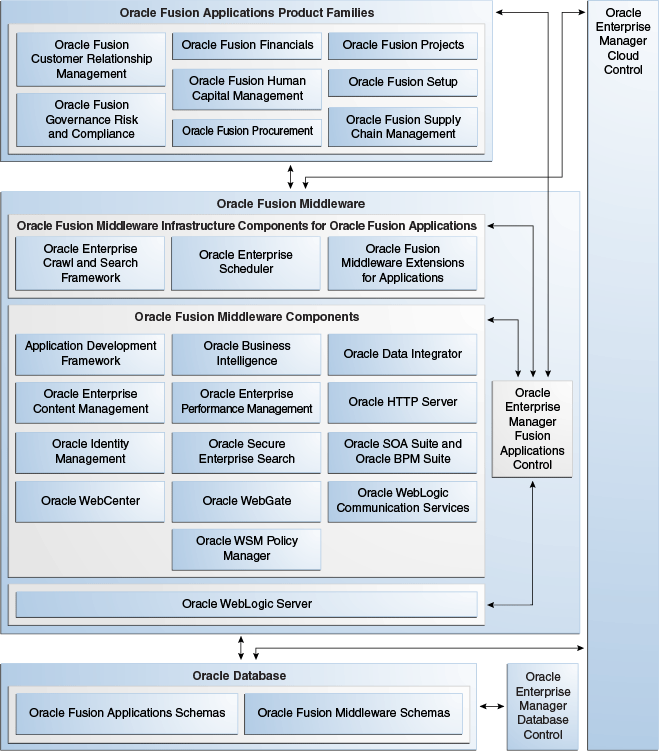
2.1.1 Oracle Fusion Applications Product Families and Product Offerings
An installation of Oracle Fusion Applications is logically broken up into groups of features. Each set of features is known as product offerings, which represent the highest-level collection of functionality that can be licensed and implemented. A product family is a collection of one or more product offerings. During installation, select a product offering or a combination of offerings as a way to install the Oracle Fusion Applications products to be used.
Product families are dependent on companion applications—for example, Oracle Fusion Human Capital Management relies on Oracle Fusion Financials payroll—and Oracle Fusion Middleware components such as Oracle SOA Suite. The wizard allows for application and middleware configuration at the domain level during domain topology configuration.
When selecting particular product offerings within a configuration rather than all of them, the wizard starts the managed servers only for the selected offerings. However, because the dependency details for the entire configuration are included in the response file, additional functionality can be activated later using Oracle Fusion Applications Functional Setup Manager to start the other managed servers.
Oracle Fusion Applications includes the product families and product offerings described in the following table.
Table 2-1 Product Offerings
| Oracle Fusion Applications Product Families | Oracle Fusion Applications Product Offerings | Description |
|---|---|---|
|
Oracle Fusion Customer Relationship Management |
|
Manages customers, contracts, and resources, including data quality configuration. |
|
Oracle Fusion Financials |
|
Manages financial flows, including assets, ledgers, cash cycle, invoices and payments, accounts receivable, collections, and setup of subledger accounting and tax configuration. |
|
Oracle Fusion Governance, Risk, and Compliance (Not installed by Oracle Fusion Applications.) |
This product family is not installed by Oracle Fusion Applications. Download the software from Oracle Software Delivery Cloud and install it separately. |
Provides critical business controls to manage risk, multi-regulatory compliance, and controls enforcement. The connector for Oracle Fusion Applications provides a prebuilt solution for managing Separation of Duties (SoD) within and across product families. Use also Oracle Fusion Governance, Risk, and Compliance to analyze suspect transactions and configuration settings based on user defined conditions. This allows organizations to actively determine the risk that exists within their application that can materially impact the reliability of the information that exists for reporting and decision making purposes. Finally, Oracle Fusion Governance, Risk, and Compliance can apply preventive controls that will limit what a user can see and do within an Oracle Fusion Applications user interface according to user-defined conditions. The objective is to pro-actively mitigate the risk of extraneous access or improper transactions from existing. |
|
Oracle Fusion Human Capital Management |
|
Provides employee management for an organization. |
|
Oracle Fusion Procurement |
Procurement |
Manages the procurement process including requisitions, purchase orders, and supplier negotiations. |
|
Oracle Fusion Project Portfolio Management |
Projects |
Manages projects, including how to plan, budget, forecast, collect costs, bill customers, and report performance. |
|
Oracle Fusion Supply Chain Management |
|
Integrates and automates all key supply chain processes, from design, planning and procurement to manufacturing and fulfillment, providing a complete solution set to enable companies to power information-driven value chains. |
|
Oracle Fusion Setup |
This product family is installed along with all product offerings. |
Supports the other product families. In addition to Oracle Fusion Functional Setup Manager for setting up functional data, this product family includes applications to assist application users:
|
Table 2-2 Product Offering and Dependent Weblogic Server Domains
| Oracle Fusion Applications Product Families | Oracle Fusion Applications Product Offering | Provisioned Weblogic Server Domains (Primary + Dependent Domains) |
|---|---|---|
|
Oracle Fusion Customer Relationship Management |
Customer Data Management |
Oracle Business Intelligence, Common, Oracle Identity Management,Oracle Fusion Customer Relationship Management, Oracle Fusion Financials, Oracle Fusion Human Capital Management |
|
Oracle Fusion Customer Relationship Management |
Enterprise Contracts |
Oracle Business Intelligence, Common, Oracle Identity Management,Oracle Fusion Customer Relationship Management, Oracle Fusion Financials, Oracle Fusion Human Capital Management |
|
Oracle Fusion Customer Relationship Management |
Marketing |
Oracle Business Intelligence, Common, Oracle Identity Management,Oracle Fusion Customer Relationship Management, Oracle Fusion Financials, Oracle Fusion Human Capital Management, Oracle Fusion Supply Chain Management |
|
Oracle Fusion Customer Relationship Management |
Sales |
Oracle Business Intelligence, Common, Oracle Identity Management,Oracle Fusion Customer Relationship Management, Oracle Fusion Financials, Oracle Fusion Human Capital Management, Oracle Fusion Supply Chain Management |
|
Oracle Fusion Incentive Compensation |
Incentive Compensation |
Oracle Business Intelligence, Common, Oracle Identity Management,Oracle Fusion Customer Relationship Management, Oracle Fusion Financials, Oracle Fusion Human Capital Management, Oracle Fusion Incentive Compensation |
|
Oracle Fusion Financials |
Financials |
Oracle Business Intelligence, Common, Oracle Identity Management,Oracle Fusion Customer Relationship Management, Oracle Fusion Financials, Oracle Fusion Human Capital Management, Oracle Fusion Project Portfolio Management, Oracle Fusion Supply Chain Management |
|
Oracle Fusion Financials |
Fusion Accounting Hub |
Oracle Business Intelligence, Common, Oracle Identity Management,Oracle Fusion Customer Relationship Management, Oracle Fusion Financials, Oracle Fusion Human Capital Management |
|
Oracle Fusion Human Capital Management |
Compensation Management |
Oracle Business Intelligence, Common, Oracle Identity Management,Oracle Fusion Customer Relationship Management, Oracle Fusion Financials, Oracle Fusion Human Capital Management |
|
Oracle Fusion Human Capital Management |
Workforce Deployment |
Oracle Business Intelligence, Common, Oracle Identity Management,Oracle Fusion Customer Relationship Management, Oracle Fusion Financials, Oracle Fusion Human Capital Management |
|
Oracle Fusion Human Capital Management |
Workforce Development |
Oracle Business Intelligence, Common, Oracle Identity Management,Oracle Fusion Customer Relationship Management, Oracle Fusion Financials, Oracle Fusion Human Capital Management |
|
Oracle Fusion Procurement |
Procurement |
Oracle Business Intelligence, Common, Oracle Identity Management,Oracle Fusion Customer Relationship Management, Oracle Fusion Financials, Oracle Fusion Human Capital Management, Oracle Fusion Project Portfolio Management, Oracle Fusion Supply Chain Management |
|
Oracle Fusion Project Portfolio Management |
Projects |
Oracle Business Intelligence, Common, Oracle Identity Management,Oracle Fusion Customer Relationship Management, Oracle Fusion Financials, Oracle Fusion Human Capital Management, Oracle Fusion Procurement, Oracle Fusion Project Portfolio Management, Oracle Fusion Supply Chain Management |
|
Oracle Fusion Supply Chain Management |
Materials Management and Logistics |
Oracle Business Intelligence, Common, Oracle Identity Management,Oracle Fusion Customer Relationship Management, Oracle Fusion Financials, Oracle Fusion Human Capital Management, Oracle Fusion Supply Chain Management |
|
Oracle Fusion Supply Chain Management |
Order Orchestration |
Oracle Business Intelligence, Common, Oracle Identity Management,Oracle Fusion Customer Relationship Management, Oracle Fusion Financials, Oracle Fusion Human Capital Management, Oracle Fusion Supply Chain Management |
|
Oracle Fusion Supply Chain Management |
Product Management |
Oracle Business Intelligence, Common, Oracle Identity Management,Oracle Fusion Customer Relationship Management, Oracle Fusion Financials, Oracle Fusion Human Capital Management, Oracle Fusion Supply Chain Management |
|
Oracle Fusion Supply Chain Management |
Supply Chain Financial Orchestration |
Oracle Business Intelligence, Common Oracle Identity Management, Oracle Fusion Customer Relationship Management, Oracle Fusion Financials, Oracle Fusion Human Capital Management, Oracle Fusion Supply Chain Management |
|
Oracle Fusion Supply Chain Management |
Manufacturing and Supply Chain Material Management |
Oracle Business Intelligence, Common Oracle Identity Management, Oracle Fusion Customer Relationship Management, Oracle Fusion Financials, Oracle Fusion Human Capital Management, Oracle Fusion Supply Chain Management |
|
Oracle Fusion Supply Chain Management |
Price Management |
Oracle Business Intelligence, Common Oracle Identity Management, Oracle Fusion Customer Relationship Management, Oracle Fusion Financials, Oracle Fusion Human Capital Management, Oracle Fusion Supply Chain Management |
|
Oracle Fusion Supply Chain Management |
Value Chain Planning |
Oracle Business Intelligence, Common, Oracle Identity Management, Oracle Fusion Customer Relationship Management, Oracle Fusion Financials, Oracle Fusion Human Capital Management, Oracle Fusion Supply Chain Management |
2.1.2 New Product Offerings, Applications, Oracle WebLogic Server Managed Servers, and Clusters for Release 12
The following new product offerings, applications, Oracle WebLogic Server Managed Servers, and clusters were added in this release.
| Component | On Premise | SaaS | Comments |
|---|---|---|---|
|
Product Offering |
NA |
Student Management |
Available for SaaS |
|
Product Offering |
NA |
Recruiting and Candidate Experience |
Available for SaaS |
|
Domain |
NA |
HigherEd (HED) |
Available for SaaS |
|
Applications |
NA |
(HED) Campus Community |
Available for SaaS |
|
Applications |
NA |
(HED) Financials Management |
Available for SaaS |
|
Applications |
NA |
(HED) Records Management |
Available for SaaS |
|
Applications |
NA |
(HED) Ess |
Available for SaaS |
|
Applications |
NA |
(HED) SOA |
Available for SaaS |
|
Applications |
Applications Core Ess |
Applications Core Ess |
Available for on premise and SaaS |
|
Applications |
NA |
Learn |
Available for SaaS |
|
Applications |
NA |
Recruiting and Candidate Experience |
Available for SaaS |
|
Applications |
NA |
HCM Sem Search |
Available for SaaS |
|
Managed Server / Cluster |
NA |
(HED) Campus Community |
Available for SaaS |
|
Managed Server / Cluster |
NA |
(HED) Campus Community |
Available for SaaS |
|
Managed Server / Cluster |
NA |
(HED) Records Management |
Available for SaaS |
|
Managed Server / Cluster |
NA |
(HED) Ess |
Available for SaaS |
|
Managed Server / Cluster |
NA |
(HED) SOA |
Available for SaaS |
|
Managed Server / Cluster |
NA |
Recruiting |
Available for SaaS |
|
Managed Server / Cluster |
NA |
Hcm Sem Search |
Available for SaaS |
2.1.3 Oracle Fusion Middleware Infrastructure Components
The product families use the following common core framework and infrastructure for Oracle Fusion Applications described in the following table.
Table 2-3 Oracle Fusion Middleware Infrastructure Components
| Oracle Fusion Middleware Infrastructure Component | Description |
|---|---|
|
Oracle Fusion Middleware Extensions for Applications (Applications Core) |
Provides design time and runtime infrastructure to help standardize complex development patterns for Oracle Fusion Applications. It simplifies the development process of these patterns and provides a consistent user experience. Examples of these patterns include extensibility (Flexfields), hierarchical relationships (Trees), data security, and UI patterns. Applications Core creates simplified methods of implementing these complex requirements by providing robust metadata and comprehensive UI components and services. All of the Applications Core components have been intricately integrated with the rest of the Oracle Fusion Middleware infrastructure so they are available across every layer of the Oracle Fusion Applications platform. Applications Core provides shared libraries referenced by all the Oracle Fusion Applications, a standalone application for application setup and configuration, an Oracle JDeveloper extension to seamlessly integrate our components with the rest of the Oracle Fusion Applications technology stack, PLSQL APIs, C libraries, and common seed data. |
|
Oracle Enterprise Scheduler |
Enables to manage and schedule jobs for Oracle Fusion Applications. |
|
Oracle Enterprise Crawl and Search Framework (ECSF) |
Oracle Enterprise Crawl and Search Framework (ECSF) enables Oracle Fusion Applications Search for performing full-text searches securely and simultaneously against multiple logical business objects. Any application that connects to multiple data sources or manages a significant amount of unstructured (non-database) information—or both—needs advanced search capabilities so that application users can easily locate and take action on data that is relevant to them. |
2.1.4 Oracle Fusion Middleware Components
A complete installation of Oracle Fusion Applications includes several Oracle and third party products. The majority of installed products form the core of the Oracle Fusion Applications environment, and are installed regardless of the offerings selected during provisioning. Some products are installed only when selecting particular product offerings, while others must be installed manually following provisioning.
Oracle Fusion Middleware includes the components described in the following table.
Except where otherwise stated, all products are installed during Oracle Fusion Applications provisioning and are enabled by default.
MANDATORY: Install Oracle Database Server before running Oracle Fusion Applications provisioning.
MANDATORY: Before running the Oracle Identity Management Provisioning Wizard, install Oracle Java HotSpot and Oracle Database Server and run the Oracle Fusion Middleware RCU.
Table 2-4 Oracle Fusion Middleware Components
| Oracle Fusion Middleware Components | Description |
|---|---|
|
Oracle Access Manager |
Provides the core functionality of Web Single Sign On (SSO), authentication, authorization, centralized policy administration and agent management, real-time session management, and auditing. Installed by Oracle Identity Management provisioning. |
|
Oracle Application Development Framework |
Provides an end-to-end application framework that builds on Java Platform, Enterprise Edition (Java EE) standards and open-source technologies to simplify and accelerate implementing service-oriented applications. |
|
Oracle BI Enterprise Edition and Oracle Business Intelligence Applications |
Oracle Business Intelligence provides a complete, integrated solution of analytics and reporting for Oracle Fusion Applications. Oracle Business Intelligence Applications is installed manually post-provisioning, and is not enabled by default. The Oracle Fusion Applications installation and provisioning process installs the Oracle BI Applications software components in the Business Intelligence Oracle home but does no further setup. To finish setting up Oracle BI Applications, follow the instructions in Installing and Setting Up Oracle Business Intelligence Applications in the Oracle Business Intelligence Applications Installation Guide. |
|
Oracle Database Server and Client |
The Oracle Database contains the schemas and tablespaces required for both the Oracle Fusion Applications and for the applications. Oracle Fusion Applications does not support other databases. Oracle Database Server must be installed before running Oracle Fusion Applications provisioning and Oracle Identity Management provisioning. |
|
Oracle Data Integrator |
Oracle Data Integrator provides a comprehensive data integration platform that covers bulk data movement requirements for Oracle Fusion Applications. |
|
Oracle Directory Services Manager |
Provides a graphical administrative interface for Oracle Internet Directory. Installed by Oracle Identity Management provisioning. |
|
Oracle Global Order Promising |
A comprehensive order promising solution that determines, based on the current and projected demands and supplies across a supply chain and on an extended supply chain, when a customer order can be fulfilled. This is installed only when selecting Oracle Supply Chain Management. |
|
Oracle HTTP Server |
Provides a web listener for applications and the framework for hosting static and dynamic pages and applications over the web. Based on the proven technology of the Apache HTTP Server, Oracle HTTP Server includes significant enhancements that facilitate load balancing, administration, and configuration. Installed by Oracle Identity Management provisioning. |
|
Oracle Internet Directory |
A general-purpose LDAPv3 compliant directory storage, Oracle Internet Directory serves as the central user repository for Oracle Identity Management. Installed by Oracle Identity Management provisioning. |
|
Oracle Java HotSpot |
Oracle Java HotSpot is installed by Oracle Fusion Applications provisioning. Oracle Java HotSpot JDK must be installed prior to running Oracle Identity Management provisioning. |
|
Oracle Secure Enterprise Search |
Provides a search engine for Oracle Fusion Applications Search. |
|
Oracle WebCenter Content |
Provides a comprehensive suite of digital content management tools. These tools can be used across the enterprise to cohesively track, manage, and dispose of content whether written, in digital images, or as email. |
|
Oracle WebCenter Portal |
Enables to create social applications, enterprise portals, collaborative communities, and composite applications, built on a standards-based, service-oriented architecture. Oracle WebCenter Portal combines dynamic user interface technologies with which to develop rich internet applications, the flexibility and power of an integrated, multichannel portal framework, and a set of horizontal Enterprise 2.0 capabilities delivered as services that provide content, collaboration, presence, and social networking capabilities. Based on these components, Oracle WebCenter Portal also provides an out-of-the-box, enterprise-ready customizable application, WebCenter Spaces, with a configurable work environment that enables individuals and groups to work and collaborate more effectively. |
|
WebGate for Oracle Access Manager |
Acts as a communicator plug-in that accepts users requests through Oracle HTTP Server and communicates with Oracle Access Manager. Installed by Oracle Identity Management provisioning. |
|
Oracle WebLogic Communication Services |
Provides click-to-dial functionality for applications primarily through contextual actions. Contextual actions provide related information and actions to users within the immediate context of the object instances upon which they act. |
|
Oracle WebLogic Server |
Supports the deployment of mission-critical applications in a robust, secure, highly available, and scalable environment. Oracle WebLogic Server is an ideal foundation for building applications based on service-oriented architecture (SOA). Installed by Oracle Identity Management provisioning. |
|
Oracle Web Tier |
Includes components that interact with end users at the outermost tier of application grid infrastructure, typically through HTTP requests and responses. Hosts web pages and provides security and high performance along with built-in clustering, load balancing, and failover features |
2.1.4.1 Products Installed to the Desktop
In addition to the server-side products installed by the provisioning tools, Oracle Fusion Applications uses the following products that are installed on the desktop.
-
Oracle BI Enterprise Edition plus client
-
Oracle Data Integrator Studio
-
Oracle JDeveloper
2.1.4.2 Other Related Products
The following Oracle and third-party products are sometimes used to interact directly with Oracle Fusion Applications.
-
Microsoft Active Directory: Used to integrate with Oracle Identity Management to provide identity information to Oracle Fusion Applications.
-
Other Applications: Additional applications such as Oracle eBusiness Suite, Oracle PeopleSoft Human Capital Management, and Oracle Siebel Customer Relationship Management can be configured to integrate with Oracle Fusion Applications.
2.1.5 Oracle Database
The Oracle Database contains the schemas and tablespaces required for both the Oracle Fusion Applications and for the applications. Oracle Fusion Applications does not support other databases.
Oracle Fusion Applications encryption APIs mask data such as credit card numbers in application user interface fields. For encryption and masking beyond that, Transparent Data Encryption (TDE) and Oracle Database Vault (ODV) are certified but optional with Oracle Fusion Applications.TDE and ODV provide information life cycle protections, such as the following:
-
Data access restrictions on database administrators and other privileged users
-
Sensitive data at rest in database files and file backups
-
Sensitive data in transit
-
Sensitive attributes in non-production databases
ODV establishes limitations on the power of privileged users to access sensitive data through segregation of duties policies on DBA roles and by securely consolidating application data in the database. These limitations prevent DBAs and other privileged users from overriding the protections placed on sensitive data by the Virtual Private Database (VPD). Oracle Fusion Applications deploys with the ODV enabled when it is installed. TDE prevents access to personally identifiable information in the file system or on backups or disk. TDE protects confidential data, such as credit card and social security numbers. TDE encrypts sensitive table data stored in data files at the tablespace level.
2.1.6 Oracle Fusion Applications Management Tools
The primary administrative management tool for Oracle Fusion Applications is Enterprise Manager Cloud Control. It provides an integrated interface to manage the entire environment. For information about Enterprise Manager Cloud Contol, see Get Started with Enterprise Manager Cloud Control in the Oracle Fusion Applications Administrator’s Guide.
A collection of native tools, including Oracle Enterprise Manager Fusion Applications Control and WebLogic Server Control, still exist in the environment. Information about accessing them can be found in Use Other Oracle Fusion Applications Administration Tools in the Oracle Fusion Applications Administrator’s Guide.
2.2 Oracle Fusion Applications Topologies
Both Oracle Identity Management and Oracle Fusion Applications provisioning offer several topology options which allow to tailor the Oracle Fusion Applications environment, including server allocation, networking, and availability.
There are numerous possible topological permutations, but most topologies fall into a few categories with small variations (such as the use of a demilitarized zone, shared servers, or reverse proxy). These categories are:
-
Basic topology. This is the simplest type of topology possible directly out-of-the-box.
-
Enterprise topology. This type of topology is ideal for testing environments where high availability is not necessary.
-
Enterprise topology with high availability. This type of topology is ideal for Oracle Fusion Applications production environments.
The diagrams in each topology example show logical units, rather than individual servers, representing components of the Oracle Fusion Applications installation. Each unit can be installed to its own server, or multiple units can share a single server, depending on the needs of your enterprise.
2.2.1 Topology Tiers
The Oracle Fusion Applications topologies use a tier-based model that is logically grouped into three tiers: the database tier, middle tier (split into directory and application tiers in Oracle Identity Management), and web tier.
This tier-based model is useful when mapping the Oracle Fusion Applications topology to the type of environment created, fitting the topology to the corporate network location policies, and, consequently, determining where the components should reside in the network.
For example:
-
The company may have a firewall-protected subnet reserved for all production databases. Typically, this is where the databases are deployed, and the database tier resides.
-
The company may have a demilitarized zone (DMZ) where all externally-accessible web servers reside. Typically, this is where the web tier resides, and the web tier components such as the Oracle HTTP Servers and Webgate for Oracle Access Manager are deployed.
-
The company may have a policy that specifies that application-specific HTTP servers may not reside in the DMZ. In such cases, the web tier should be deployed to the internal network along with the mid tier, with a reverse proxy in the DMZ that forwards all external requests to the web tier in the internal network.
Topology tiers are also related to high availability requirements. For a highly available Oracle Fusion Applications environment, each tier must be handled and scaled out independently.
2.2.1.1 Database Tier
In an Oracle Fusion Applications environment, the database tier includes all the databases used for both Oracle Fusion Applications and Oracle Identity Management. For more information about the databases that are part of the Oracle Fusion Applications environment, see Database Instances and Other Processes.
2.2.1.2 Middle Tier
The middle tier includes all the components between the database tier and the web tier. Components in the middle tier include Oracle WebLogic Servers and the applications deployed on the servers, among other things.
Middle tier components are not accessible directly by end users. Access to the applications in the middle tier is achieved through the web tier, which is ideal for environments where complete isolation between end users and the application is required.
The middle tier consumes information provided from all other tiers as well as itself:
-
The middle tier accesses data stored in any of the Oracle Fusion Applications or Oracle Identity Management databases on the database tier via JDBC or SQL*Net.
-
The middle tier directly accesses the Oracle Identity Management directory tier via LDAP for identity, policy, and credential data.
-
Certain middle tier applications and components communicate amongst themselves using direct calls via protocols such as T3, HTTP, and TCP sockets.
-
For HTTP requests, certain middle tier applications and components communicate amongst each other through calls to the web tier, which then forwards the request to other components in the middle tier.
For Oracle Identity Management, the middle tier is split into two tiers: the directory tier and application tier.
2.2.1.2.1 Oracle Identity Management Directory Tier
The Oracle Identity Management directory tier is the deployment tier where all the LDAP services reside. This tier includes products such as Oracle Internet Directory. The directory tier is managed by directory administrators providing enterprise LDAP service support.
The Directory Tier stores identity information, which contains information about users and groups.
Although the topology diagrams do not show LDAP directories other than Oracle Internet Directory, use Microsoft Active Directory to store identity information. However, always store policy information in Oracle Internet Directory. Store identity information in Oracle Internet Directory or another directory.
2.2.1.2.2 Oracle Identity Management Application Tier
The Oracle Identity Management application tier is the place where Oracle Identity Management Java EE applications are deployed. The main Java EE components deployed to this tier include Oracle Directory Services Manager and Oracle Enterprise Manager Fusion Middleware Control.
The Oracle Identity Management applications on the application tier interact with the directory tier for enterprise identity information and, in some cases, for application metadata. Oracle Enterprise Manager Fusion Middleware Control and Oracle Directory Services Manager provide allow to manage and administer the components in the application and directory tiers.
2.2.1.3 Web Tier
The web tier contains the Oracle HTTP Servers as well as Webgate for Oracle Access Manager. It is the only tier that can be accessed by end users in Oracle Fusion Applications, and forwards end-user HTTP requests to the applications and components running in the middle tier.
In Oracle Fusion Applications, the web tier can have a load balancer or reverse proxy as a front end. The load balancer or reverse proxy handle all HTTP requests meant for the web tier.
The web tier can be placed in the DMZ if desired, providing end-user access to the services from the middle tier on that side of the firewall.
2.2.2 Network Components
The enterprise and enterprise with high availability topologies involve the use of a load balancer or reverse proxy.
-
Reverse proxy: The reverse proxy stands between the Oracle Fusion Applications web tier and HTTP clients (end users and external applications). The main purpose of a reverse proxy is to act as a gateway to Oracle Fusion Applications, particularly for network configurations in which clients are using a different subnet from Oracle Fusion Applications. Reverse proxies are recommended for environments using the enterprise topology.
-
Load balancer: The load balancer is the intermediary between the Oracle Fusion Applications environment and both internal and external clients, where internal clients are Oracle Fusion Applications components and external applications include end users and external applications. The load balancer distributes HTTP requests among servers in the web tier, and TCP requests among the LDAP servers hosting the identity store, policy store, and Oracle Universal Content Management. The load balancer also acts as a gateway for external clients to the Oracle Fusion Applications environment, much like the reverse proxy.
From the perspective of provisioning, the configuration for a load balancer or reverse proxy is essentially the same. The following table summarizes the differences between using a reverse proxy and a load balancer in the context of Oracle Fusion Applications.
Table 2-5 Load Balancer or Reverse Proxy
| Functionality | Load Balancer | Reverse Proxy |
|---|---|---|
|
Acts as an HTTP gateway to Oracle Fusion Applications. |
Yes |
Yes |
|
Provides high availability through load balancing. |
Yes |
No |
|
Used for external HTTP traffic. |
Yes |
Yes |
|
Used for internal HTTP traffic. |
Yes |
Yes or no |
|
Used for LDAP traffic. |
Yes |
No |
|
Used for TCP traffic to Oracle WebCenter Content (UCM). |
Yes |
No |
2.2.3 Basic Topology
Figure 2-2 Oracle Fusion Applications Basic Topology
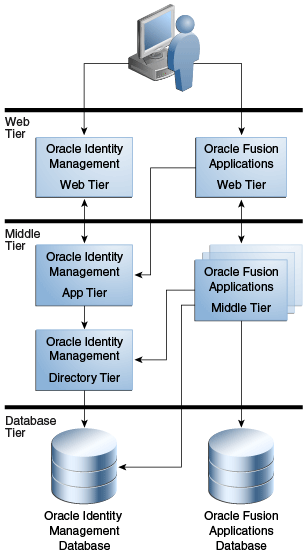
The basic topology is the most rudimentary of possible Oracle Fusion Applications environments, making it a good choice for development or demonstration or proof of concept purposes. It is also the easiest to install, with minimal hardware requirements. In fact, all the components can be installed to the same server, given sufficiently robust hardware. Alternatively, Oracle Fusion Applications domains can be installed to more than one machine so as to better support Oracle Fusion Applications memory requirements. No additional network components are required as all communication is server-to-server.
The features of an Oracle Fusion Applications environment with a basic topology are shown in the following table.
Table 2-6 Features of the Basic Topology
| Feature | Used in Topology? |
|---|---|
|
Nodes |
2 or more |
|
Oracle Identity Management and Oracle Fusion Applications shared node for middle and web tiers |
Yes |
|
Oracle Identity Management and Oracle Fusion Applications web tier DMZ setup |
No |
|
Reverse proxy or load balancer |
No |
|
High availability |
No |
|
Expandable post-installation |
Limited |
Sample configurations of the basic topology are shown in the following table. The following notation is used in the table:
-
Oracle Fusion Applications: FA
-
Oracle Identity Management: IDM
-
Oracle Fusion Applications Database: FA DB
-
Oracle Identity Management Database: IDM DB
The asterisk (*) following FA indicates that Oracle Fusion Applications can be split among multiple nodes.
MANDATORY: Install Oracle Identity Management Middle Tier and Oracle Fusion Applications Middle Tier on different hosts. Installing Oracle Identity Management and Oracle Fusion Applications on the same host is not a supported topology.
MANDATORY: Do not share the same database instance for Oracle Identity Management and Oracle Fusion Applications.
MANDATORY: The database instances must also be running on physical host(s).
Table 2-7 Sample Configurations of the Basic Topology
| Number of Nodes | Components per Node | Sample Host Names |
|---|---|---|
|
2 |
|
fahostN.mycompany.com idmhost.mycompany.com |
|
3 |
|
fahostN.mycompany.com idmhost.mycompany.com dbhost.mycompany.com |
|
3 |
|
fahostN.mycompany.com fadbhost.mycompany.com idmhost.mycompany.com |
|
4 |
|
fahostN.mycompany.com fadbhost.mycompany.com idmhost.mycompany.com Idmdbhost.mycompany.com |
2.2.4 Enterprise Topology
Figure 2-3 Oracle Fusion Applications Enterprise Topology
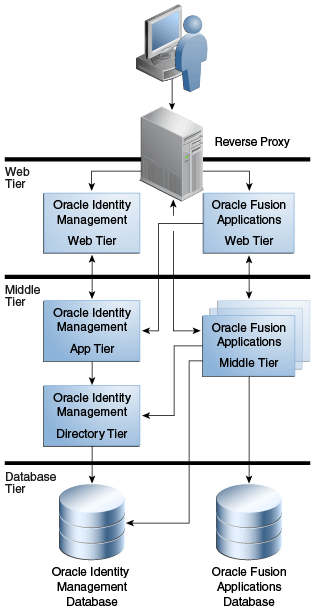
The enterprise topology is the most flexible of Oracle Fusion Applications environments, in that it can be expanded following installation. This topology is useful for testing environments in which high availability is not required. The topology features a clear differentiation amongst the web, application, and data tiers. Install Oracle Fusion Applications domains to more than one machine so as to better support memory requirements. The Oracle Identity Management middle tier can be installed to a maximum of two nodes using the Oracle Identity Management Provisioning Wizard, but additional nodes can be added manually post-install. The use of a reverse proxy is recommended for greater flexibility.
The features of an enterprise topology Oracle Fusion Applications environment are shown in the following table.
Table 2-8 Features of the Enterprise Topology
| Feature | Used in Topology? |
|---|---|
|
Nodes |
4 or more |
|
Oracle Identity Management and Oracle Fusion Applications shared node for middle and web tiers |
No |
|
Oracle Identity Management and Oracle Fusion Applications web tier DMZ setup |
Optional |
|
Reverse proxy or load balancer |
Recommended |
|
High availability |
No |
|
Expandable post-installation |
Yes |
Sample configurations of the enterprise topology are shown in the following table. The following notation is used in the table:
-
Oracle Fusion Applications: FA Web
-
Oracle Fusion Applications Middle Tier: FA Mid
-
Oracle Identity Management: IDM Mid
-
Oracle Identity Management Web Tier: IDM Web
-
Oracle Fusion Applications Database: FA DB
-
Oracle Identity Management Database: IDM DB
The asterisk (*) following FA Mid indicates that the Oracle Fusion Applications middle tier can be split among multiple nodes. The asterisk (*) following IDM Mid indicates that the Oracle Identity Management middle tier can be split amongst two nodes.
Table 2-9 Sample Configurations of the Enterprise Topology
| Number of Nodes | Node Contains | Sample Host Names |
|---|---|---|
|
4 |
|
webhost.mycompany.com fahost.mycompany.com idmhost.mycompany.com dbhost.mycompany.co |
|
4 |
|
webhost.mycompany.com fahost.mycompany.com idmhost.mycompany.com fadbhost.mycompany.com |
|
5 |
|
webhost.mycompany.com fahost.mycompany.com idmhost.mycompany.com idmdbhost.mycompany.com fadbhost.mycompany.com |
|
6 |
|
idmwebhost.mycompany.com fawebhost.mycompany.com fahost.mycompany.com idmhost.mycompany.com idmdbhost.mycompany.com fadbhost.mycompany.com |
2.2.5 Enterprise Topology with High Availability
Figure 2-4 Oracle Fusion Applications Enterprise Topology with High Availability

The enterprise topology with high availability is the ideal Oracle Fusion Applications topology for production environments. The topology features a clear differentiation amongst the web, application, and data tiers. Install Oracle Fusion Applications domains to more than one machine so as to better support memory requirements. The Oracle Identity Management middle tier can be installed to a maximum of two nodes using the Oracle Identity Management Provisioning Wizard, but additional nodes can be added manually post-installation. The use of a reverse load balancer is required to manage HTTP and TCP traffic.
The features of an enterprise topology Oracle Fusion Applications environment with high availability are shown in the following table.
Table 2-10 Features of the Enterprise Topology with High Availability
| Feature | Used in Topology? |
|---|---|
|
Nodes |
8 or more |
|
Oracle Identity Management and Oracle Fusion Applications shared node for middle and web tiers |
No |
|
Oracle Identity Management and Oracle Fusion Applications web tier DMZ setup |
Optional |
|
Reverse proxy or load balancer |
Yes |
|
High availability |
Yes |
|
Expandable post-installation |
Yes |
Sample configurations of the enterprise topology with high availability are shown in the following table. The following notation is used in the table:
-
Oracle Fusion Applications: FA Web
-
Oracle Fusion Applications Middle Tier: FA Mid
-
Oracle Identity Management: IDM Mid
-
Oracle Identity Management Web Tier: IDM Web
-
Oracle Fusion Applications Database: FA DB
-
Oracle Identity Management Database: IDM DB
The asterisk (*) following FA Mid indicates that the Oracle Fusion Applications middle tier can be split among multiple nodes. The asterisk (*) following IDM Mid indicates that the Oracle Identity Management middle tier can be split amongst two nodes.
Table 2-11 Sample Configurations of the Enterprise Topology with High Availability
| Number of Nodes | Node Contains | Sample Host Names |
|---|---|---|
|
8 |
|
webhost1.mycompany.com… webhostN.mycompany.com fahost1.mycompany.com… fahostN.mycompany.com idmhost1.mycompany.com… idmhostN.mycompany.com dbhost1.mycompany.com… dbhostN.mycompany.com |
|
8 |
|
webhost1.mycompany.com… webhostN.mycompany.com fahost1.mycompany.com… fahostN.mycompany.com idmhost1.mycompany.com… idmhostN.mycompany.com fadbhost1.mycompany.com… fadbhostN.mycompany.com |
|
10 |
|
webhost1.mycompany.com… webhostN.mycompany.com fahost1.mycompany.com… fahostN.mycompany.com idmhost1.mycompany.com… idmhostN.mycompany.com idmdbhost1.mycompany.com… idmdbhostN.mycompany.com fadbhost1.mycompany.com… fadbhostN.mycompany.com |
|
12 |
|
idmwebhost1.mycompany.com… idmwebhostN.mycompany.com fawebhost1.mycompany.com… fawebhostN.mycompany.com fahost1.mycompany.com... fahostN.mycompany.com idmhost1.mycompany.com… idmhostN.mycompany.com idmdbhost1.mycompany.com… idmdbhostN.mycompany.com fadbhost1.mycompany.com… fadbhostN.mycompany.com |
2.3 Oracle Fusion Applications Directory Structure
After the Oracle Fusion Applications environment has been installed, the storage and directory layout will vary depending on the following factors:
-
Paths selected during the provisioning process
-
Whether the local configuration option was selected during the provisioning process
-
Host names provided during the provisioning process
2.3.1 Installation Repository
The following diagram depicts the directory structure for the installation repository, which is created from the Oracle Fusion Applications install zip files that are downloaded. The installation repository should be placed on a shared disk. The installation repository is only required during the installation process. It is no longer needed once the installation is complete.
The root directory for the installation repository is REPOSITORY_LOCATION.
Figure 2-5 Directory Structure for the Installation Repository
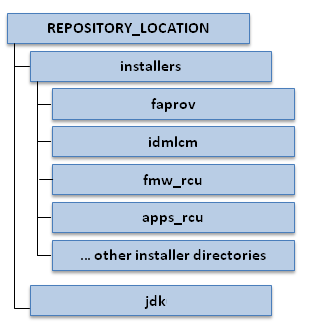
The directory structure is as follows, as shown in the previous diagram:
-
REPOSITORY_LOCATION -
REPOSITORY_LOCATION/installers -
REPOSITORY_LOCATION/installers/faprov -
REPOSITORY_LOCATION/installers/idmlcm -
REPOSITORY_LOCATION/installers/fmw_rcu -
REPOSITORY_LOCATION/installers/apps_rcu -
REPOSITORY_LOCATION/jdk
2.3.2 Oracle Identity Management Provisioning Framework Directory Structure
The Oracle Identity Management provisioning framework should be installed on a shared disk. The framework will have the directory layout shown in the following figure.
The directory to which the Oracle Identity Management provisioning framework is to be installed is IDMLCM_HOME.
Figure 2-6 Oracle Identity Management Provisioning Framework Directory Structure

The directory structure shown in the previous figure is listed as follows:
-
IDMLCM_HOME -
IDMLCM_HOME/provisioning -
IDMLCM_HOME/provisioning/bin -
IDMLCM_HOME/provisioning/ant -
IDMLCM_HOME/provisioning/lib -
IDMLCM_HOME/provisioning/provisioning-build -
IDMLCM_HOME/provisioning/provisioning-plan -
IDMLCM_HOME/provisioning/template -
IDMLCM_HOME/provisioning/util -
IDMLCM_HOME/provisioning/idm-provisioning-build -
IDMLCM_HOME/cfgtoollogs -
IDMLCM_HOME/common -
IDMLCM_HOME/diagnostics -
IDMLCM_HOME/inventory -
IDMLCM_HOME/Opatch -
IDMLCM_HOME/oui -
IDMLCM_HOME/patch -
IDMLCM_HOME/scripts
2.3.3 Oracle Fusion Applications Provisioning Framework Directory Structure
The Oracle Fusion Applications provisioning framework should be installed on a shared disk. The following diagram shows the directory structure of the provisioning framework.
The directory to which the Oracle Fusion Applications provisioning framework is to be installed is FAPROV_HOME.
Figure 2-7 Oracle Fusion Applications Provisioning Framework Directory Structure
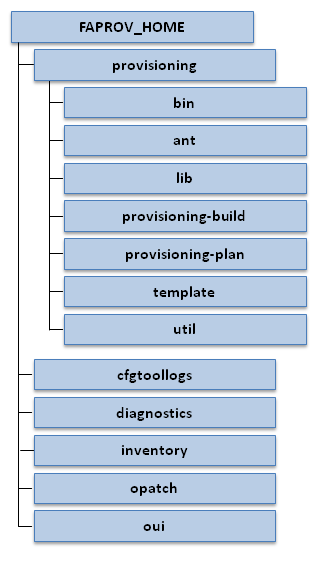
The directory structure shown in the previous figure is listed as follows:
-
FAPROV_HOME -
FAPROV_HOME/provisioning -
FAPROV_HOME/provisioning/bin -
FAPROV_HOME/provisioning/ant -
FAPROV_HOME/provisioning/lib -
FAPROV_HOME/provisioning/provisioning-build -
FAPROV_HOME/provisioning/provisioning-plan -
FAPROV_HOME/provisioning/template -
FAPROV_HOME/provisioning/util -
FAPROV_HOME/cfgtoollogs -
FAPROV_HOME/diagnostics -
FAPROV_HOME/inventory -
FAPROV_HOME/Opatch -
FAPROV_HOME/oui
2.3.4 Oracle Identity Management Shared Directory Structure
The Oracle Identity Management directory structure may be placed in shared storage or in a combination of shared and local storage. The following diagram shows the shared directory structure.
The root directory for Oracle Identity Management product binary files is IDM_BASE. The root directory for Oracle Identity Management configuration and instance files is IDM_CONFIG.
The following diagram shows the structure of the shared Oracle Identity Management directories.
Figure 2-8 Oracle Identity Management Shared Directory Structure
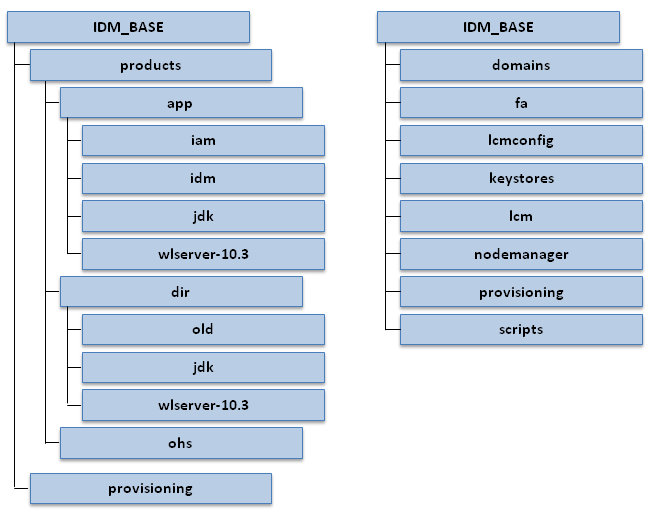
The shared directory structure described in the previous diagram is listed here:
Table 2-12 Oracle Identity Management Shared Directory Structure
| IDM_BASE | IDM_CONFIG |
|---|---|
|
|
2.3.5 Oracle Identity Management Local Directory Structure
If local domain configuration is selected during Oracle Identity Management provisioning (INSTALL_LOCALCONFIG_ENABLE=true), certain Oracle Identity Management configuration directories are stored locally. All servers containing WebLogic Server domains or Oracle Application Server instances contain this directory.
The local root directory for Oracle Identity Management as defined by the provisioning wizard is IDM_LOCAL_CONFIG. The directory structure is shown in the following diagram.
Figure 2-9 Oracle Identity Management Local Directory Structure

The Oracle Identity Management local directory structure shown in the previous diagram is as follows:
-
IDM_LOCAL_CONFIG -
IDM_LOCAL_CONFIG/domains -
IDM_LOCAL_CONFIG/instances
If local domain configuration is not selected during Oracle Identity Management provisioning, the Oracle Identity Management local directory structure is present in the shared directory location itself.
2.3.6 Oracle Identity Management DMZ Directory Structure
If he DMZ option is selected during Oracle Identity Management provisioning (WEBTIER_DMZINSTALL_ENABLE=true), the web tier Oracle Fusion Middleware home as well as the OHS instance directory are stored locally to the DMZ. The directory path used is the same as that for the shared storage, being IDM_BASE for the Fusion Middleware home and IDM_CONFIG for the configuration directory.
The root directory in the local configuration as defined by the provisioning wizard is IDM_LOCAL_CONFIG.
Additionally, if the local domain configuration option is selected during Oracle Identity Management provisioning (INSTALL_LOCALCONFIG_ENABLE=true), certain configuration directories are stored locally under the directory defined for IDM_LOCAL_CONFIG.
The following diagram illustrates the Oracle Identity Management DMZ directory structure.
Figure 2-10 Oracle Identity Management DMZ Directory Structure
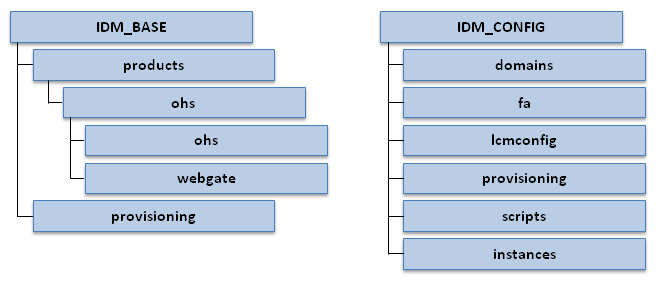
The directory structure shown in the previous diagram is as follows:
Table 2-13 Oracle Identity Management DMZ Directory Structure
| IDM_BASE | IDM_CONFIG |
|---|---|
|
|
If the DMZ option is not selected during Oracle Identity Management provisioning, the Oracle Identity Management DMZ directory structure is present in the shared directory location itself.
2.3.7 Oracle Fusion Applications Shared Directory Structure
The Oracle Fusion Applications directory structure may be stored in a shared directory or in a combination of shared and local storage.
The root directory for the Oracle Fusion Applications product binary files is APPLICATIONS_BASE. The root directory for the Oracle Fusion Applications configuration and instance files is APPLICATIONS_CONFIG.
The following diagram illustrates the Oracle Fusion Applications shared directory structure.
Figure 2-11 Oracle Fusion Applications Shared Directory Structure
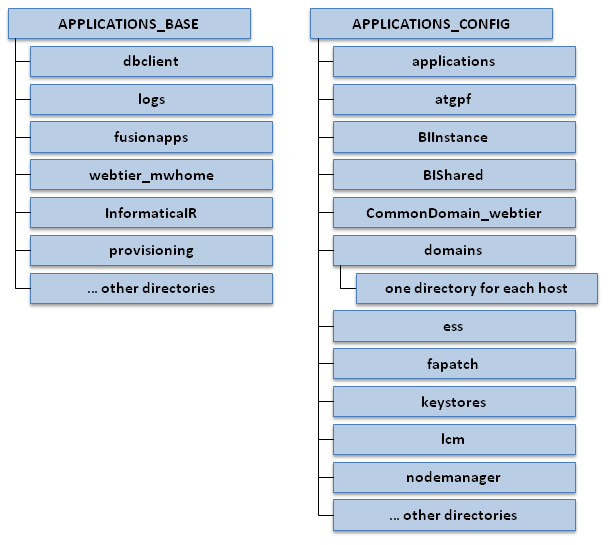
The Oracle Fusion Applications shared directory structure shown in the previous diagram is listed as follows.
Table 2-14 Oracle Fusion Applications Shared Directory Structure
| APPLICATIONS_BASE | APPLICATIONS_CONFIG |
|---|---|
|
|
The BIIInstance directory is placed on shared storage only if the local domains configuration option is not selected.
The CommonDomain_webtier directory is placed in shared storage only if the DMZ option is not selected.
2.3.7.1 Applications Base Directory
When an environment consists of multiple hosts, a central, shared provisioning installation directory is required so that the location is visible to all provisioned hosts. To achieve this setup, the use of full host names is required. Alias names are not recommended.
The top-level directory for the Oracle Fusion Applications binaries is the applications base. Specify a name for this directory at the time of provisioning. This directory includes two mount points: /net/mount1/appbase (APPLICATIONS_BASE) for components that remain read-only after provisioning, and /net/mount2 (APPLICATIONS_CONFIG) to contain instances that are configurable after provisioning. This structure aids performance issues and accommodates a "lock-down" of binaries after provisioning. It ensures that the configurable components remain available.
The applications base directory must not be set to the system root directory or set to the root directory of a logical drive. Some life cycle management tools compute directory names by backing up one directory level from the applications base directory and then appending the appropriate subdirectory name. These tools will fail if the applications base directory is set to the system root directory or set to the root directory of a logical drive because it is not possible to back up one directory level from the system root directory or from the root directory of a logical drive.
2.3.7.2 Oracle Fusion Applications Oracle Home Directory
In the context of Oracle Fusion Applications directory structures, the term home directory generally refers to a directory that contains one or more Oracle Fusion Middleware homes or Oracle Fusion Applications homes, which groups together related Oracle product offerings.
As the home directory is read-only, update it only by using Oracle Fusion Applications life cycle tools, such as Provisioning, Upgrade Orchestrator, and Patch Manager.
The Oracle Fusion Applications Oracle home directory (FA_ORACLE_HOME) is located under the APPLICATIONS_BASE/fusionapps directory (net/mount1/appbase/fusionapps). The /fusionapps directory is an Oracle Fusion Applications Middleware home (APPLICATIONS_BASE/fusionapps). Figure 2-12 shows this directory structure.
Figure 2-12 Oracle Fusion Applications Oracle Home

The Oracle home contains the following subdirectories:
-
/fusionapps/applications/lcm: The life cycle management directory. Contains the patching framework artifacts in the following subdirectories:
-
../ad/bin: Patching framework software and executables, including C artifacts and configuration scripts, that set the environment and start the corresponding utility.
-
../ad/java: Java artifacts.
-
../ad/db/sql: Database artifacts and SQL files.
-
../ad/lib: Application libraries.
-
../ad/template: Configuration files or templates delivered and used by the patching framework during configuration activities.
-
-
/fusionapps/applications/bin: Executables called by Enterprise Scheduler Service jobs.
-
/fusionapps/applications/product_family: Container directory for artifacts specific to a product configuration, for example,
/ORACLE/fusionapps/fin. -
/fusionapps/applications/admin: Patching framework environment properties file (FUSION_env.properties), Oracle Fusion Applications AutoPatch, and the patching logs, reports, and administration files. These files are required by Oracle Fusion Applications Patch Manager.
-
/fusionapps/applications/lib: Applications-specific libraries.
-
/fusionapps/applications/OPatch: Contains the OPatch utility called by Oracle Fusion Applications Patch Manager when patching middleware artifacts.
For complete information about patching the applications environment, see Introduction to Patching Oracle Fusion Applications in the Oracle Fusion Applications Patching Guide.
2.3.7.3 Oracle Fusion Applications Product Family Directory
The Oracle Fusion Applications .../product_family directory is located under the FA_ORACLE_HOME directory. This structure exists for each of the product configurations (product families) deployed in the Oracle Fusion Applications environment during provisioning. Figure 2-13 shows this directory structure.
Figure 2-13 Oracle Fusion Applications Product Family Directory

The following subdirectories are located under the .../product_family directory:
-
/fusionapps/applications/product_family/product: Product grouping within a product family. For example,
/fusionapps/applications/fin/arrepresents the Account Receivables product in the Financials product family.-
/db/plsql/: PL/SQL packages and bodies for a given product, for example,
.../fin/ar/db/plsql/arp_process_line.pkh. -
/db/sql/: SQL scripts for a given product. For example,
.../fin/ar/db/sql/ar_ar_rev_rec_typ_type.sql. -
/db/data/lba/US/: Product-specific seed data files, striped by Logical Business Area (LBA). Note that sub-directories could exist in the top-level seed data directory because some LBAs can have sub-LBAs. For example,
.../fin/ar/db/data/FinArCustomers/US/ArlookupTypeSD.xlf.
-
-
/fusionapps/applications/product_family/deploy: Container directory for deployable artifacts, composites, Java EE applications (such as Oracle Application Development Framework and Oracle Enterprise Scheduler Service).
-
/fusionapps/applications/product_family/security/: Product family directory containing security-related files.
2.3.8 Oracle Fusion Applications Local Directory Structure
If the local domain configuration option is selected during Oracle Fusion Applications provisioning (INSTALL_LOCALCONFIG_ENABLE=true), certain configuration directories are stored locally. All servers containing domains or Oracle Application Server instances will include this directory.
The local root configuration directory as defined in the provisioning wizard is IDM_LOCAL_CONFIG.
The following diagram illustrates the Oracle Fusion Applications shared directory structure.
Figure 2-14 Oracle Fusion Applications Local Directory Structure
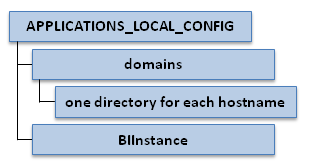
The directory structure shown in the previous diagram is listed here.
-
APPLICATIONS_LOCAL_CONFIG -
APPLICATIONS_LOCAL_CONFIG/domains -
APPLICATIONS_LOCAL_CONFIG/domains/one directory for each host name -
APPLICATIONS_LOCAL_CONFIG/BIInstance
2.3.9 Oracle Fusion Applications DMZ Directory Structure
If the DMZ option is selected during Oracle Fusion Applications provisioning (WEBTIER_DMZINSTALL_ENABLE=true), the web tier Fusion Middleware home and the OHS instance directory are stored locally to the DMZ. The directory path used is the same as that defined for shared storage (APPLICATIONS_BASE for the Fusion Middleware home and APPLICATIONS_CONFIG for the configuration directory).
The tool local configuration directory as defined in the provisioning wizard is APPLICATIONS_LOCAL_CONFIG.
Additionally, if the local domain configuration option is selected during Oracle Identity Management provisioning (INSTALL_LOCALCONFIG_ENABLE=true), certain configuration directories are stored locally under the directory defined for APPLICATIONS_LOCAL_CONFIG.
The following diagram illustrates the Oracle Fusion Applications DMZ directory structure.
Figure 2-15 Oracle Fusion Applications DMZ Directory Structure

The directory structure shown in the previous diagram is listed here.
Table 2-15 Oracle Fusion Applications DMZ Directory Structure
| APPLICATIONS_BASE | APPLICATIONS_CONFIG |
|---|---|
|
|
2.4 Oracle Fusion Applications Runtime Processes
A running Oracle Fusion Applications environment includes the following runtime processes:
-
Databases: These include Oracle Fusion Applications and Oracle Identity Management databases; Oracle Fusion Applications data warehouse.
-
Oracle Application Server instances: Run C-based and Java SE components. These include Oracle Internet Directory, Oracle Fusion Applications HTTP server, Oracle Identity Management HTTP server, Oracle Global Order Processing, and Oracle Business Intelligence.
-
Oracle WebLogic Server domains: These run Java EE-based components, and include administration and managed servers, as well as the node manager.
2.4.1 Database Instances and Other Processes
Both Oracle Identity Management and Oracle Fusion Applications have their own databases, as listed in the following table.
Table 2-16 Database Instances in Oracle Fusion Applications
| Provisioned Environment | Database | Sample Schemas | Comments |
|---|---|---|---|
|
Oracle Identity Management |
Oracle Identity Management Database |
|
Contains the schemas for Oracle Identity Management products such as Oracle Access Manager. |
|
Oracle Identity Management |
Oracle Internet Directory Database |
|
Contains the Oracle Internet Directory schemas. Optional as a separate database, otherwise the Oracle Identity Management database is used. |
|
Oracle Fusion Applications |
Transactional Database |
|
Contains the transactional schemas for Oracle Fusion Applications. |
|
Oracle Fusion Applications |
Data warehouse Database |
|
Contains the schemas for the Oracle Fusion Applications Datawarehouse. |
2.4.2 Oracle Application Server Instances
Oracle Application Server instances in the Oracle Fusion Applications environment are listed here.
Application Server Instances in the Provisioned Oracle Identity Management Environment
-
Oracle Internet Directory
-
Oracle Identity Federation
-
Oracle HTTP Server
Application Server Instances in the Oracle Fusion Applications Environment
-
Oracle Global Order Promising
-
Oracle HTTP Server
-
Oracle Business Intelligence
2.4.3 Oracle WebLogic Server Domains
The topology for an applications environment centers around a set of predefined Oracle WebLogic Server domains. The provisioning process creates these domains during the physical installation. It then deploys the product offerings selected for installation in the associated product family domain. It also deploys common applications for use by all product offerings and their dependent middleware components.
After provisioning is complete, scale out Oracle Fusion Middleware components, such as Oracle HTTP Server and Oracle SOA Suite, and product domains, such as Oracle Fusion Customer Relationship Management domain, Oracle Fusion Common domain, Oracle Fusion Human Capital Management domain, and so on.
A WebLogic Server domain is a logically related group of Oracle WebLogic Server resources that is managed as a unit. It consists of an Administration Server and one or more Managed Servers. A managed server hosts components and associated resources that constitute each product configuration. The domains are predefined to ensure that product offerings and their dependencies are always stored in a standardized arrangement.
In each domain, every Managed Server belongs to a cluster. A cluster is a group of Oracle WebLogic Servers that work together to provide scalability and high availability for applications. A cluster appears as a single Oracle WebLogic Server instance. The Managed Server instances that constitute a cluster can run on the same host or be located on different hosts. Applications are deployed to the cluster, which implies deployment to every Managed Server within the cluster.
The WebLogic Server domains run Java EE-based components and include administration and managed servers, as well as the node manager.
The WebLogic Server domains that are part of a Oracle Fusion Applications environment are listed here.
WebLogic Server Domains in the Provisioned Oracle Identity Management Environment
-
IDMDomain. Always available.
WebLogic Server Domains in the Provisioned Oracle Fusion Applications Environment
-
CommonDomain. Always available.
-
HCMDomain. Always available.
-
CRMDomain. Always available.
-
FinancialsDomain. Always available.
-
BIDomain. Always available.
-
SCMDomain. Available only with the following offerings: Oracle Fusion Customer Relationship Management, Oracle Fusion Financials, and Oracle Fusion Supply Chain Management.
-
ProcurementDomain. Available only with the following offerings: Oracle Fusion Financials and Oracle Fusion Supply Chain Management.
-
ProjectsDomain. Available only with the following offering: Oracle Fusion Financials.
-
ICDomain. Available only with the following offering: Oracle Fusion Incentive Compensation.
-
OSNDomain. Available only when Oracle Social Network is configured.
-
HigherEdDomain. Available only in SaaS when Student Management is configured.
For more information about the enterprise deployment of domains and instructions about scale out, see Complete Conditional Common High Availability Post-Installation Tasks for Oracle Fusion Applications.
2.5 Access Oracle Fusion Applications
End users access Oracle Fusion Applications through a set of URLs defined during the provisioning process (the provisioning wizard calls them external URLs). Depending on whether the topology includes a load balancer or reverse proxy, Oracle Fusion Applications URL endpoints may be at the load balancer or reverse proxy, or directly at the Oracle HTTP Server.
The main end user entry point to Oracle Fusion Applications is generally a URL similar to the following:
https://fusionapps-common.mycompany.com/homePage
Each product family may have its own host name or port, depending on the web tier and load balancer configuration in the provisioning wizard.
Administrators can access the administration consoles through a set of internal or administrative URLs defined in the provisioning wizard. Administrators can use Oracle Enterprise Manager Fusion Applications Control and Oracle Enterprise Manager Cloud Control Console to manage the Oracle Fusion Applications environment.
As with all URLs in Oracle Fusion Applications, access is subject to authentication through Oracle Access Manager.
For more information about using Fusion Applications Control and Cloud Control Console, see Get Started with Enterprise Manager Cloud Control in the Oracle Fusion Applications Administrator's Guide.